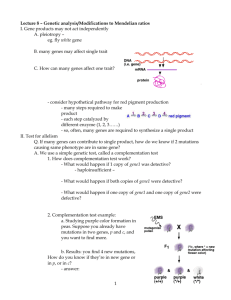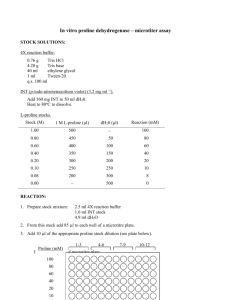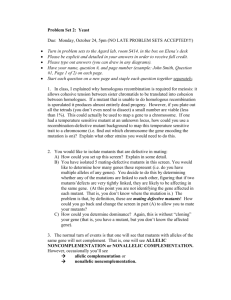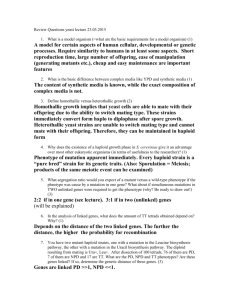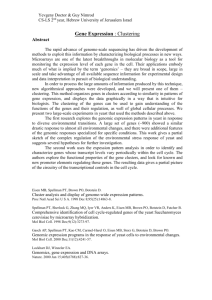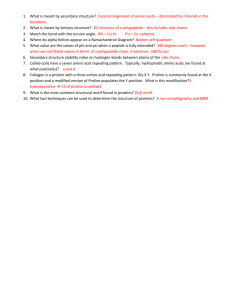S1 Genetics
advertisement
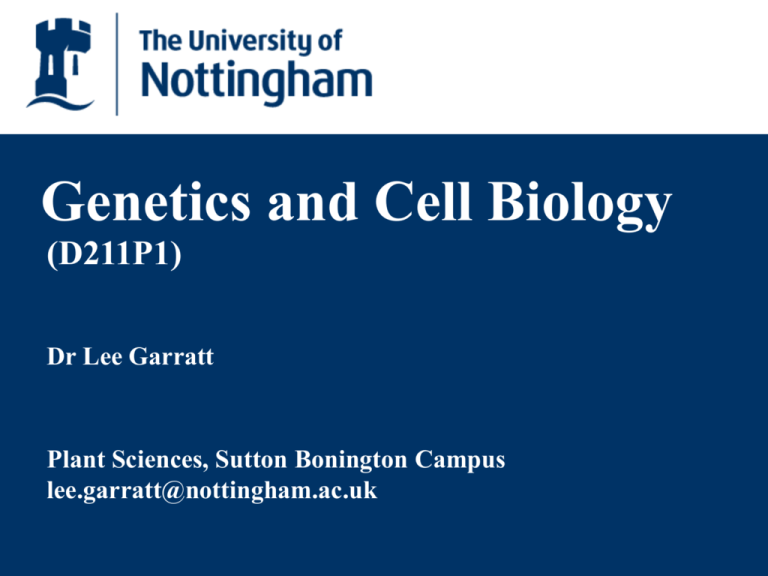
Genetics and Cell Biology (D211P1) Dr Lee Garratt Plant Sciences, Sutton Bonington Campus lee.garratt@nottingham.ac.uk Lecture content: Complementation Collinearity of Gene & Protein Genetic Code tRNA & Translation Bacterial RNA Transcription The lac Operon What is Genetics? Genetics tries to answer four questions: A) What are genes – what is their structure? B) How do genes work? C) How are genes passed on to the next generation?* D) How do genes change with evolution? *Dr Ian Taylor will cover (C). Complementation Haploid and diploid organisms DIPLOID organisms have two copies of each chromosome. HAPLOID organisms have one copy of each chromosome. and of each gene. and of each gene. Haploid and diploid organisms Most higher organisms are diploid, though most go through a haploid stage in the life cycle. This may be extensive in some (e.g. mosses). Bacteria and viruses are haploid. Haploid and diploid organisms If a gene is mutated in a haploid organism, the effect will be seen immediately as a mutant phenotype. In a diploid organism, this may not happen because the unmutated (wild type) copy of the gene will be dominant over the mutated one. Dominance is related to complementation. Microorganisms Microorganisms are good for genetic studies because: 1. They are small and simple so they have few genes. 2. Some grow on simple defined media – inorganic salts & sugar. 3. The generation time is very short (20 minutes for some bacteria). Microorganisms Yeast is a microorganism that is normally haploid but can be induced to fuse and grow as a diploid. Yeast has no visible features so we can’t get mutations that change eye colour etc. but we can get nutritional mutants. One such mutant cannot make the amino acid proline and will only grow if you add proline to the growth medium. Dominance Take a haploid yeast cell with a normal proline biosynthesis gene and put it on a minimal medium with no added proline. Will it grow? Yes Dominance Take a haploid yeast cell with a mutated proline biosynthesis gene and put it on a minimal medium with no added proline Will it grow? No Dominance Take a diploid yeast cell with two normal proline biosynthesis genes and put it on a minimal medium with no added proline Will it grow? Yes Dominance Take a diploid yeast cell with two identical mutated proline biosynthesis genes and put it on a minimal medium with no added proline Will it grow? No Dominance These are both homozygous (Greek homos – same). They have two identical chromosomes. What about a heterozygous (Greek heteros – other) cell in which each of the same pair of chromosomes is different? Dominance Take a diploid yeast cell with one mutated proline biosynthesis gene and one normal one and put it on a One good copy minimal medium with no added of the gene is proline enough Will it grow? Yes Dominance • Each gene instructs the cell how to make a protein – in this case an enzyme needed to make proline. The cell only needs one set of instructions. • The normal gene is able to specify an enzyme that works and is dominant. The mutated gene has lost this ability and is recessive. Mutants 1 2 Each mutation is likely to be different, even if it occurs in the same gene. However, if we take a different proline requiring mutant and repeat the dominance test, we will get the same result. The yeast will grow without proline. Mutants 2 1 Take a diploid yeast cell with two different mutated proline biosynthesis genes and put it on a minimal medium with no added proline Will it grow? No Complementation 3 1 Take a diploid yeast cell with another two mutated proline biosynthesis genes and put it on a minimal medium with no added proline. Will it grow? Yes Complementation 3 2 Take a diploid yeast cell with another combination of different mutated proline biosynthesis genes and put it on a minimal medium with no added proline. Will it grow? Yes Complementation • This is one case where two wrongs can sometimes make a right. Genes that behave in this way are said to complement each other. • This obeys rules. A given pair of genes will either always complement to give a wild-type phenotype, or always not complement. Complementation • Two mutant genes that always do complement each other are said to be in different complementation groups. • Two that always don’t complement are said to be in the same complementation group. • Different groups are given different letters proA, proB, proC etc Complementation • Complementation groups arise because many biochemical changes require several chemical reactions. • Each reaction is carried out by a different enzyme and each enzyme is specified by a different gene. • There isn’t just one proline gene, there are several: proA, proB, proC etc. Complementation • Complementation is the standard genetic test to find out whether two genes have the same function. • “Genes” defined by a complementation test should not strictly be referred to as genes but as cistrons. In many cases, a cistron is the same as a gene but not always – One example is the lac operon, to be discussed in a later lecture. Cross-Feeding • Cross-feeding is related to complementation because it arises when mutations affect different steps in a biochemical pathway. • This can be seen in mutants of the bacterium Escherichia coli (often shortened to E. coli). E. coli is always haploid but it can be made diploid for part of its only chromosome (merodiploid) by a genetic trick – which we won’t go into now. Cross-Feeding • Tryptophan requiring mutants of E. coli fall into several complementation groups: trpA, trpB, trpC, trpD and trpE. • When put onto a minimal agar plate with no tryptophan, these will not grow but when several different types are spread in a particular pattern there is sometimes a little growth. Cross-Feeding Cross-Feeding • The mutants grow very slightly where they are near to another mutant. They must be getting some diffusible substance through the agar and it can’t be tryptophan. Cross-Feeding • A test shows that : • The trpB mutant needs tryptophan (nothing else will do). • The trpA mutant needs either tryptophan or indole. Cross-Feeding IGP A A B TrpA Indole enzyme Indole Trp TrpB enzyme B Complementation Complementation is similar but everything is going on in the same cell. Complementation Compound 1 A A Enzyme A Compound 2 B B Enzyme B Proline
